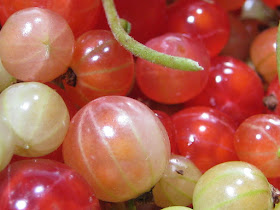Tuesday, June 19, 2012
Currants
Currants are delicious, nutritious, and easy to grow. They are nearly impossible to find in the supermarket and also difficult to buy at the farmers market. They are so easy to grow that there is no reason to not have a few bushes.
Currants have been in America since colonial days, but they fell out of favor in the early 1900s because they were an alternate host for white pine blister rust. The plant disease wasn't a significant problem for the currants, but it caused serious trouble for certain pine trees. The federal government banned currants and spent much time, money and effort to eradicate them, especially east of the Mississippi River. Eventually, they figured out that the plant disease had other hosts, and that eliminating currant bushes wasn't making much of an impact. In 1966, the ban was lifted.
There are three kinds of currants---black, red and white. The red currant bushes grow about four feet tall and benefit from a little structural assistance to help prevent them flopping over. Red currants are tiny--slightly smaller than a pea--and they grow in long, dangling clusters. White currant bushes are sometimes referred to as pink or champagne. They have a similar growth pattern as the reds. Black currants are smaller, sturdier bushes about three feet tall, with slightly larger fruits that grow in clumps close to the branches. Perhaps there is a flavor difference between the different colored fruits, but you might need some experience to develop an appreciation for those differences.
Here at Red Bucket Farm we have ten currant bushes growing in a narrow side yard under partial shade. We water the new plants for their first year, and after that we don't tend them often. They produce fruit in early summer, which we make into jams and sauces. This year we made seven pints of red currant sauce (for pancakes, yogurt, ice cream), three cups of white currant jam and six cups of black currant jam. (When making currant jam, do NOT add pectin! Currants contain plenty of natural pectin and need no extra help. Ask me how I know this.....)
The only reason I can think that currants aren't more commonly grown is that it is tedious work to pick the little fruits off the vine, but the results are delicious. I recommend growing currants in your backyard garden!




No comments:
Post a Comment